If you’re wondering why your laptop will happily charge from some USB plugs but not others, the answer is USB-C Power Delivery. We’ve rounded up some great examples you can buy right now.
It’s not quite as simple as searching for a charger with Power Delivery support, however. While some laptops will charge from a 30W adaptor, others require significantly more power. These chargers range in output up to 100W, so to find a compatible device you really need to know what is required by your particular model of laptop.
If you’re looking to fast-charge a smartphone that promises sky-high charging of, say, 65W, do note that many third-party Power Delivery chargers will not support protocols such as PPS (Programmable Power Supply) or SCP (Super Charge Protocol) that is required by proprietary fast-charging standards. You can expect 18W charging for such devices, regardless of the theoretical output of the USB-C port.
Best USB-C PD Laptop Charger Reviews
Choetech PD100W Charger – Best Overall
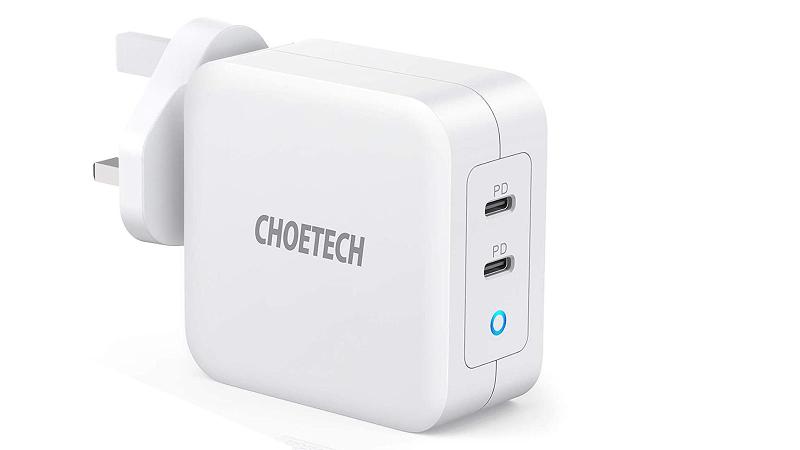
- Pros
- Excellent performance
- Excellent value
- Compact design
- Two PD outputs
- Cons
- May be overkill for some laptops
The problem with PD chargers with enough oomph to power a USB-C laptop is they can be super-expensive, and you have to be extra careful that the adaptor you choose is capable of delivering sufficient power for your particular device – as well as any laptop you might upgrade to in the near future.
We love this Choetech 100W PD charger because it is future-proofed, supporting the maximum 100W Power Delivery output on a single port. Even when both USB-C outputs are in use, each is able to deliver 45W, which is sufficient for fast-charging a phone, tablet and many (but not all) laptops.
It’s also competitively priced for a 100W charger, supports international voltages and, because it uses GaN tech, it’s a diddy little thing for such a powerful device.
Unless you need additional USB ports, we really can’t see how you’d be better served by another Power Delivery charger.
Choetech PD 65W Charger – Best Value Wall Charger
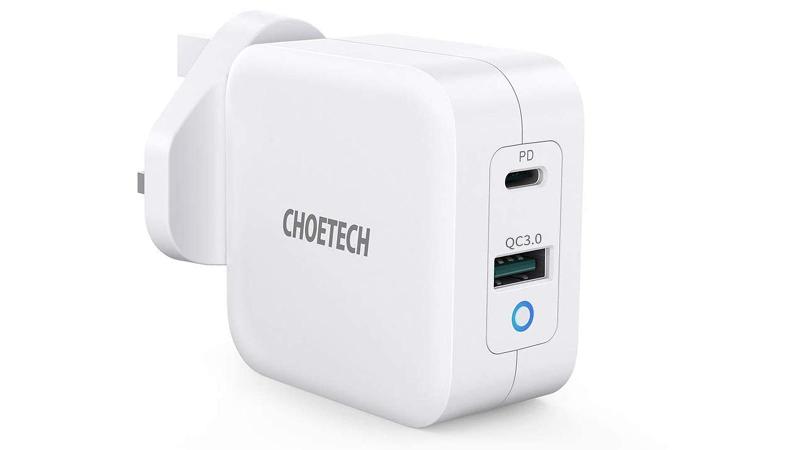
- Pros
- Excellent value
- Compact design
- Dual-USB outputs
- Cons
If you don’t need the 100W power of Choetech’s alternative Power Delivery charger, this 65W model lets you step down a little in performance and price.
It swaps out its brother’s second USB-C output for a USB-A with support for Quick Charge 3.0, making it an ideal device for simultaneously charging your phone and your laptop or tablet, whether it supports USB-C, Micro-USB or Lightning.
Like the 100W model it uses GaN tech, which means it is relatively compact as laptop chargers go.
Anker Nano II 65W GaN II PPS Fast Charger – Broadest Device Support
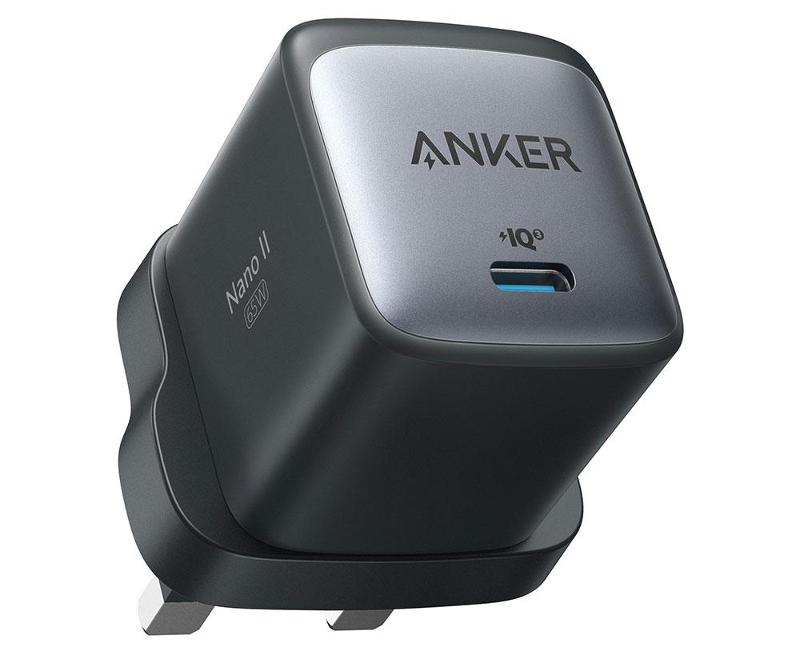
- Pros
- Reliable brand
- Super-compact
- Supports PPS
- Cons
- No cable supplied
- Only one output
Anker is perhaps one of the best-known names in charging tech, and this single-port PD charger is attractive to us for several reasons.
Gallium Nitride (GaN) technology has made chargers a fraction of the size of silicon-based models only a couple of years old, and once considered small themselves.
Anker’s new Nano II chargers utilise next-generation GaN II tech that transmits energy more efficiently and operates at twice the frequency of the first generation of GaN – making these chargers even smaller.
We haven’t seen PD chargers this small before. They are tiny – about the size of Apple’s weedy 5W iPhone charger but over 10x more powerful. The 65W Nano II charger weighs just 132g and comes in at 41.7-x-36-x-44mm. There are even smaller models at 30W and 45W.
Moreover, they support not only Power Delivery, Quick Charge and Anker’s own PowerIQ smart charging, but also PPS. This means it stands out among other third-party adaptors in its ability to fast-charge smartphones such as the Samsung Galaxy S20 that require the Super Fast Charging protocol for their proprietary charging standards.
On the downside, there is only one output, which means you can charge only one device at a time and it’ll need to support USB-C.
Nekteck 111W USB C Charger – Best Value Desktop Charger
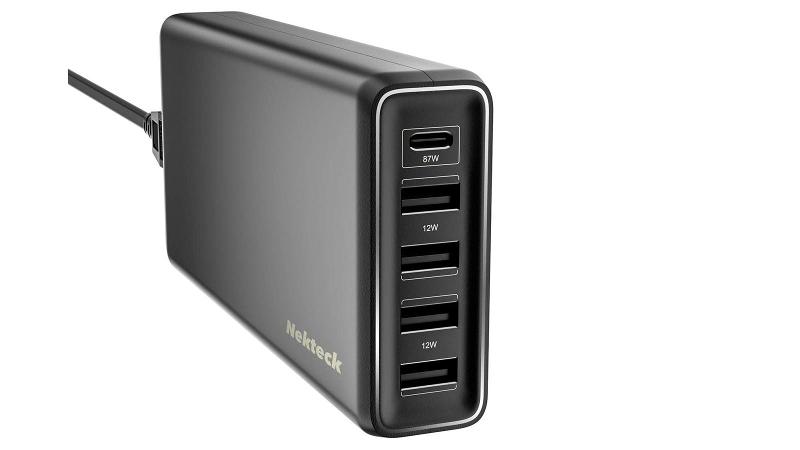
- Pros
- 5 USB outputs
- 87W PD
- Ideal for desktop use
- 100W USB-C cable in box
- Cons
- No Quick Charge/PPS support
- Messy rear design
This is a slightly different breed of charger than those we’ve discussed so far in this group test, and is what we call a desktop charger. Rather than hugging the power socket, it has a 1m extension cable that lets you plug it into the wall but bring the USB outputs themselves up to a more accessible area on the desk.
It has five USB outputs in all, making it an ideal device if you have multiple devices to charge. However, not if you have multiple laptops to charge…
Four of these five ports are full-size USB-As, rated at 12W. That’s pretty fast if you want to charge a phone, but it’s not Quick Charge-fast. Indeed, Quick Charge is not supported; nor are proprietary protocols used for various phone makers’ fast-charging standards. And the device’s maximum output with all ports in use is 111W, which means you can’t run them all at full power at once.
Yet we are drawn to the versatility of this desktop charger, plus the impressive 87W output of the single USB-C PD output. This will support any USB-C laptop, although Nekteck claims some, such as the Dell XPS 13, might restrict charging to 45W with third-party chargers.
We’re impressed to find a 100W USB-C cable is provided in the box, as this will be required to fully utilise that output.
Our only real gripe is with the design: viewed from one side it looks fine, plastic, yes, but with smooth rounded corners and a small, unobtrusive logo in the bottom corner; viewed from the other side the entire surface is filled with tech specs and safety information. Of course, this being a desktop charger, you can simply turn it on its side.
Lecone 60W USB-C Wall Charger – Cheapest Charger
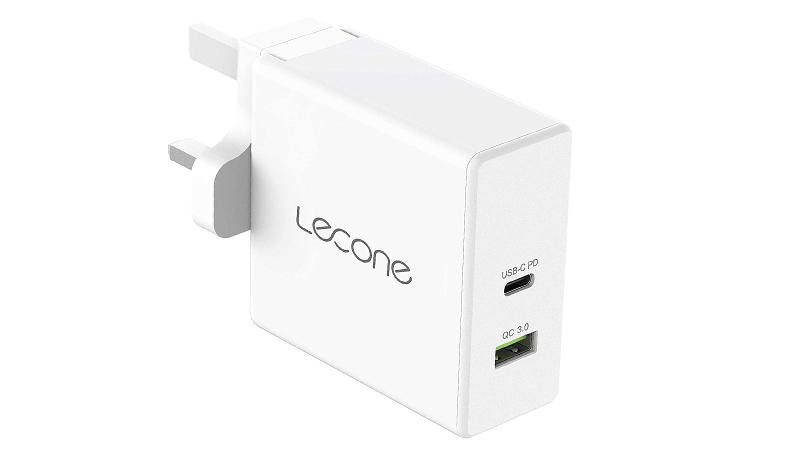
- Pros
- Very cheap
- Dual-USB outputs
- Cons
- Older model
- Lower powered and larger than some
We’re including this Lecone model here because it offers such brilliant value for a Power Delivery charger – you’ll be hard pushed to find a cheaper version. However, do note that the PD port itself can deliver only 42W (a lot, but also less than all the alternatives here), so you will need to check that it is sufficient for your laptop before you buy.
If you’re actually looking for a fast charger for your phone, this Lecone will be ideal for iPhones and older Android devices. It is itself an older device, so it isn’t going to support any recent proprietary fast-charging standards, but it does support 18W Quick Charge on its USB-A port, and Power Delivery via USB-C.
Unsurprisingly, given that its of a different generation, this adaptor is also larger and more blocky in design than some of the more expensive modern GaN chargers.
RavPower PD Pioneer 65W 2-Port Wall Charger – Most Compact Dual-Device Charger
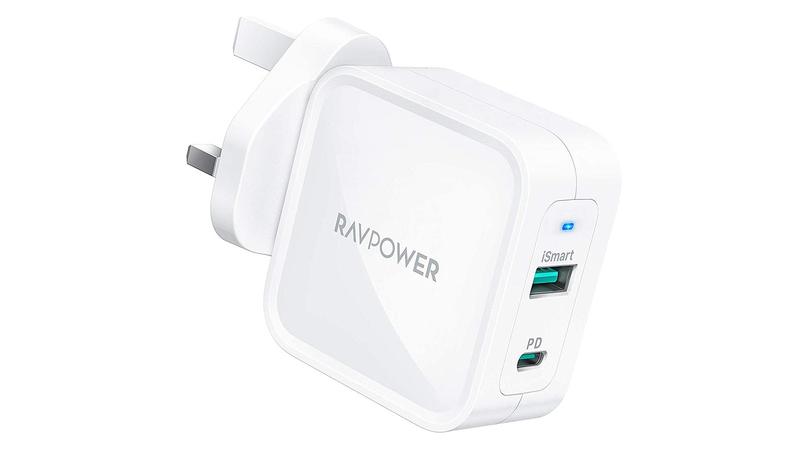
- Pros
- Super-compact design
- Dual-USB outputs
- Cons
Currently available only in the US when purchased direct from RavPower, this tiny GaN charger stands out for its dinky 55x55x31.5mm dimensions – and yet, it boasts two outputs.
The PD port is rated at 65W, which should be plenty for most USB-C laptops, but do note that this will be reduced when you also use the 15W USB-A port, with the RavPower’s maximum output rated at 65W.
We like this device for the fact it sits somewhere in between bulky muti-port desktop charger, and single-use USB-C PD charger. You almost certainly have a phone you’ll want to keep topped up in addition to your laptop on your travels, and the PD Pioneer is a space-saving device that won’t take up a huge amount of precious space in your laptop bag or travel case.
RavPower PD Pioneer 65W 4-Port Desktop Charger – Best Design
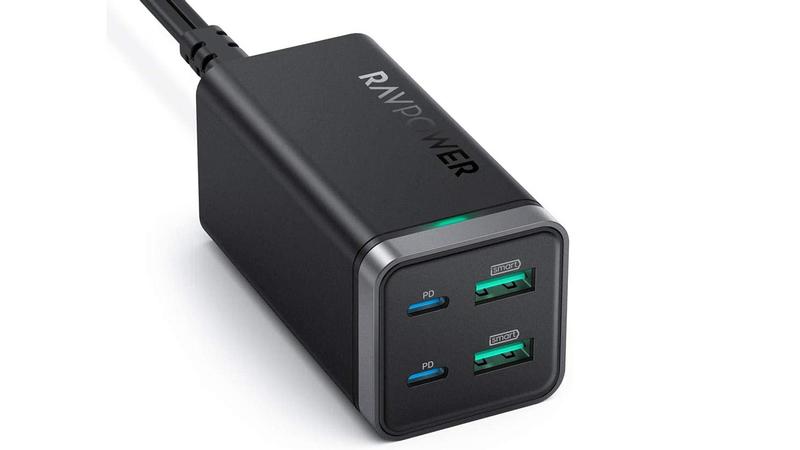
- Pros
- Stylish design
- Multiple outputs
- Cons
Unfortunately this RavPower wall charger is currently available only in the US, and only direct from RavPower, which is a real shame because we love its design. Sitting somewhere between multiport desktop charger and sleek GaN adaptor, it offers multiple fast-charging ports, but without the traditional plasticky rectangular design.
This is a matte black rectangular brick, with smooth, rounded edges, an unintrusive RavPower logo running along two of its edges and a silver trim around the end output plate. It’s incredibly compact for such a device, roughly 3in long and about 1.5in wide.
You get two PD ports, plus two full-size USB-As. Each of the two USB-C PD ports are capable of outputting 65W, while the USB-As go up to 18W with Quick Charge support. However, the maximum output of the device is 65W, so using more than one port will lower these outputs. Therefore, you should not expect it to be capable of powering two laptops at once.
With both PD ports in use one will run at 45W and one at 18W; with a PD port and a USB-A port in use you’ll see the same 45W and 18W; with two USB-A ports in use you’ll see 12W and 12W; and with all four in use you’ll get 18W from each PD port and 12W from each USB-A.
Nevertheless, this is a super-handy charger whether you want to power multiple gadgets or particularly power-hungry devices such as a laptop.
If you like this model but need a bit more power, also check out the RavPower PD Pioneer 120W (again, available only in the US). Each of its two USB-C PD ports can output 100W when used alone, but when used together each offers 60W. There are also two full-size 18W USB-A outputs, with the device’s maximum total output rated at 120W.
Currently retailing at $99.99, it is an absolute beast, and worth every penny.
Anker PowerPort III 65W – Best Travel Charger
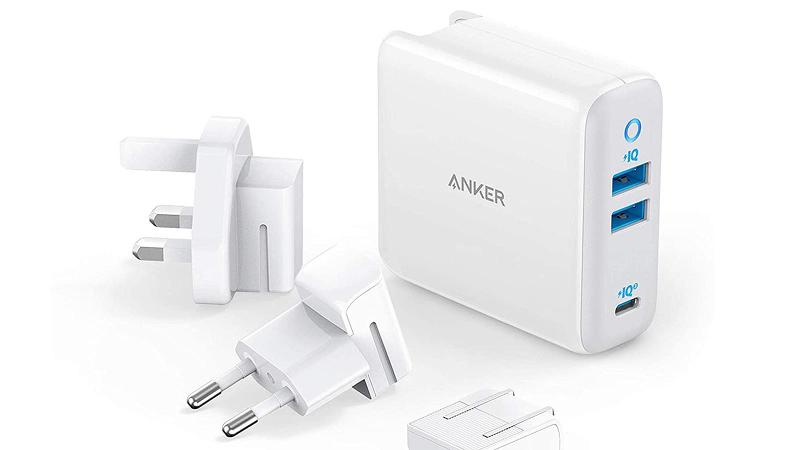
- Pros
- Interchangeable plugs for international travel
- Three USB outputs
- Cons
Anker’s PowerPort III is interesting for two key reasons: first, it has three outputs (one 45W USB-C PD, and two full-size USB-As), which makes it super-versatile; and, second, supplied in the box are interchangeable plugs for the UK, US and Europe, making it an excellent travel charger.
This is another GaN charger, which means it is delightfully small for a device that is potentially going to be consuming suitcase room.
With a 45W maximum output for the PD port, do double-check this is sufficient for your laptop before you buy. It’s also worth pointing out that unlike some of Anker’s other adaptors, which support the PPS protocol required by some devices for their proprietary fast-charging standards, this one does not.
It does support PowerIQ, however, which is Anker’s own intelligent device-detection tech, able to adjust the output for optimal charging of the connected device.
HyperJuice GaN 100W USB-C Charger – Most Powerful
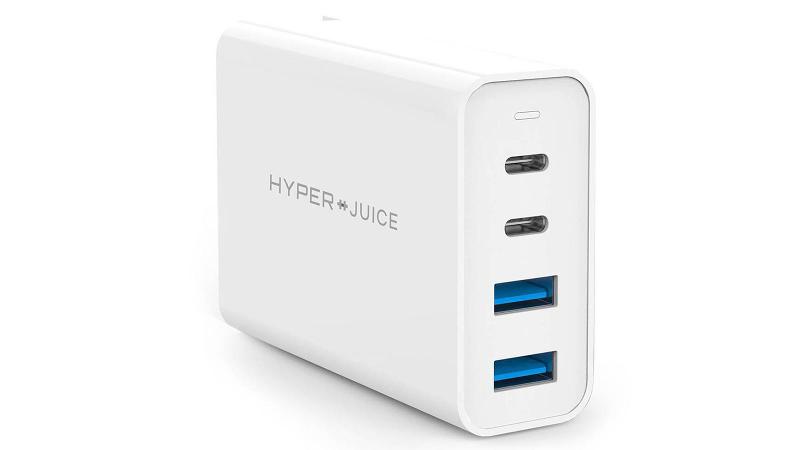
- Pros
- Two 100W PD outputs
- Multiple outputs
- Travel adaptors
- Cons
- Expensive
- Overkill for many users
As a GaN charger, the HyperJuice 100W USB-C Charger is much smaller than other PD chargers with multiple ports. It weighs 217g and will fit in your pocket – it’s the width and length of a credit card, although deeper, of course.
At 100W (PD 3.0), it’s also the most powerful we have tested – enough to full-speed power-up a large, top-end laptop plus other devices.
There are two 100W USB-C power ports, and two 15W QuickCharge 3.0 USB-A ports, which should be enough to charge most of your devices out of one charger. You could charge a laptop, tablet, and a couple of phones at the same time (maximum 100W).
It comes with US, UK, EU and AU pin converters, so should also do away with the need for a dedicated travel adapter.
The HyperJuice features over-current, over-voltage, overheating and short-circuit protection.
Satechi 75W Dual USB-C PD – Best for Multiple Power Delivery Outputs
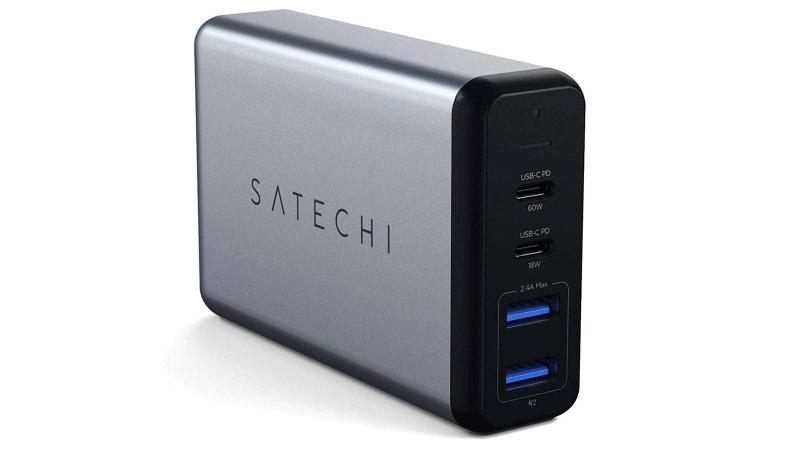
- Pros
- Multiple USB outputs
- Nicely designed
- Cons
- Second PD port is low-power
- Expensive
A version of Satechi’s desktop charger with two USB-C Power Delivery ports and two USB-A ports – especially useful if you’re travelling with more than one power-hungry USB-C device.
However, do note that one will charge at the full 60W and the other at a more sedate 18W (fine for a phone, but unlikely to be enough to power a laptop).
The two USB-A ports are handy as most of us still have devices that require a charging cable connection into this old standard.
It is light enough for travel at just 214g.
Satechi Type-C PD Car Charger (60W PD + 12W) – Best for Car Charging
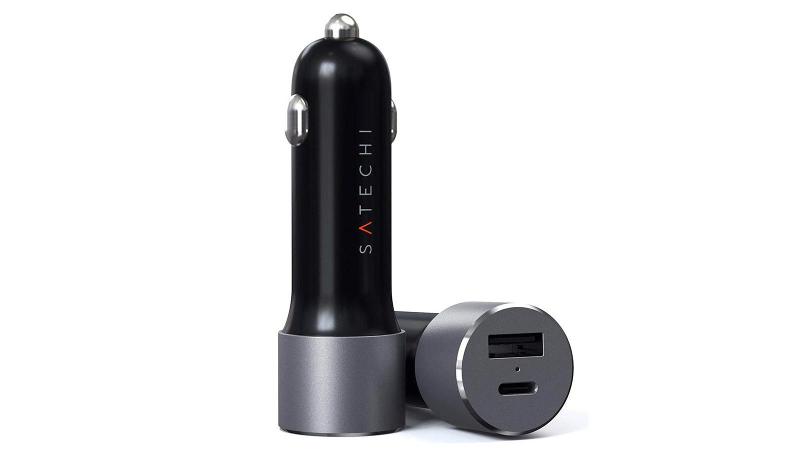
- Pros
- Powerful, on-the-go charging
- Cons
- Overkill for anything that’s not a laptop
Charging on the…
